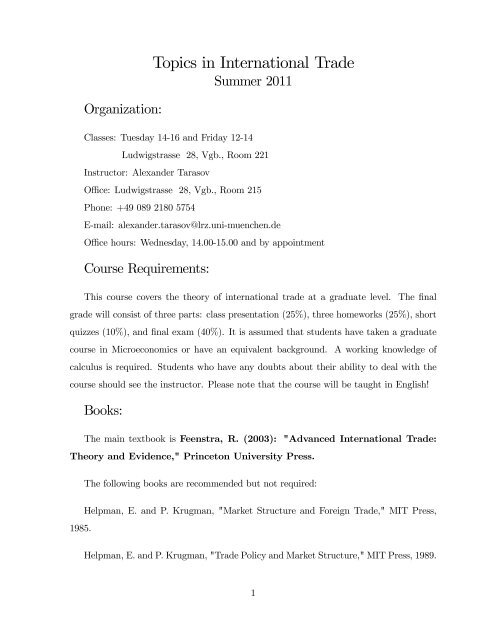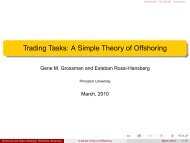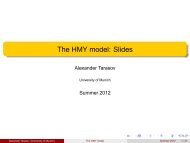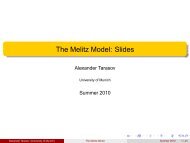Topics in International Trade
Topics in International Trade
Topics in International Trade
You also want an ePaper? Increase the reach of your titles
YUMPU automatically turns print PDFs into web optimized ePapers that Google loves.
Organization:<strong>Topics</strong> <strong>in</strong> <strong>International</strong> <strong>Trade</strong>Summer 2011Classes: Tuesday 14-16 and Friday 12-14Ludwigstrasse 28, Vgb., Room 221Instructor: Alexander TarasovO¢ ce: Ludwigstrasse 28, Vgb., Room 215Phone: +49 089 2180 5754E-mail: alexander.tarasov@lrz.uni-muenchen.deO¢ ce hours: Wednesday, 14.00-15.00 and by appo<strong>in</strong>tmentCourse Requirements:This course covers the theory of <strong>in</strong>ternational trade at a graduate level. The …nalgrade will consist of three parts: class presentation (25%), three homeworks (25%), shortquizzes (10%), and …nal exam (40%). It is assumed that students have taken a graduatecourse <strong>in</strong> Microeconomics or have an equivalent background. A work<strong>in</strong>g knowledge ofcalculus is required. Students who have any doubts about their ability to deal with thecourse should see the <strong>in</strong>structor. Please note that the course will be taught <strong>in</strong> English!Books:The ma<strong>in</strong> textbook is Feenstra, R. (2003): "Advanced <strong>International</strong> <strong>Trade</strong>:Theory and Evidence," Pr<strong>in</strong>ceton University Press.The follow<strong>in</strong>g books are recommended but not required:1985.Helpman, E. and P. Krugman, "Market Structure and Foreign <strong>Trade</strong>," MIT Press,Helpman, E. and P. Krugman, "<strong>Trade</strong> Policy and Market Structure," MIT Press, 1989.1
Grossman, Gene M. (Ed.), "Imperfect Competition and <strong>International</strong> <strong>Trade</strong>," MITPress, 1992.Helpman, E., Mar<strong>in</strong> D. and Verdier T., "The Organization of Firms <strong>in</strong> a GlobalEconomy," Harvard University Press, 2008.Course Outl<strong>in</strong>e and Read<strong>in</strong>gs:Papers and chapters marked with (**) are will be extensively covered <strong>in</strong> class. Therema<strong>in</strong><strong>in</strong>g items are suggested read<strong>in</strong>gs: items marked with (P) are papers that can bepresented <strong>in</strong> the class.1 Basic Models and Concepts1.1 Heckscher-Ohl<strong>in</strong> <strong>Trade</strong> Theory**Feenstra (2003), "Advanced <strong>International</strong> <strong>Trade</strong>: Theory and Evidence," Chapters1-2Helpman, E. and P. Krugman (1985), "Market Structure and Foreign <strong>Trade</strong>," Chapters1-2**Leamer, E. "The Leontief Paradox, Reconsidered", Journal of Political Economy,1980, Vol. 88(3), pp. 495-503.Tre‡er, D. “The Case of the Miss<strong>in</strong>g <strong>Trade</strong> and Other Mysteries,”American EconomicReview, 1995, Vol. 85(5), pp. 1029-46.Davis, D. and D. We<strong>in</strong>ste<strong>in</strong>, “An Account of Global Factor <strong>Trade</strong>,” American EconomicReview, 2001, Vol. 91(5), pp. 1423-14532
1.2 Ricardian <strong>Trade</strong> Theory**Feenstra (2003), "Advanced <strong>International</strong> <strong>Trade</strong>: Theory and Evidence," Chapter 1**Dornbusch, R., S. Fischer and P.A. Samuelson, “Comparative Advantages, <strong>Trade</strong>and Payments <strong>in</strong> a Ricardian Model with a Cont<strong>in</strong>uum of Goods,” American EconomicReview, 1977, Vol. 67(5), pp. 823-39.Matsuyama K. (2008), "Ricardian <strong>Trade</strong> Theory," The New Palgrave Dictionary ofEconomics, 2nd edition, Eds. Steven Durlauf and Lawrence Blume. Palgrave Macmillan.(work<strong>in</strong>g paper: http://faculty.wcas.northwestern.edu/~kmatsu/Ricardian%20<strong>Trade</strong>%20Theory.pdf)1.3 Monopolistic Competition and Increas<strong>in</strong>g Returns (New <strong>Trade</strong>Theory)**Feenstra (2003), "Advanced <strong>International</strong> <strong>Trade</strong>: Theory and Evidence," Chapters 5**Krugman, P. (1980), "Scale Economies, Product Di¤erentiation and the Pattern of<strong>Trade</strong>," American Economic Review, Vol. 70(5), pp. 950-59.**Davis, D. and We<strong>in</strong>ste<strong>in</strong>, D. (2003), "Market access, economic geography and comparativeadvantage: an empirical test," Journal of <strong>International</strong> Economics, 59, 1-23.Krugman, P. , “Increas<strong>in</strong>g Returns, Monopolistic Competition, and <strong>International</strong><strong>Trade</strong>,”Journal of <strong>International</strong> Economics, 1979, Vol. 9(4), pp. 469-79.Helpman, E. and P. Krugman (1985), "Market Structure and Foreign <strong>Trade</strong>," Chapters6-93
1.4 <strong>Trade</strong> Volumes and The Gravity Equation**Feenstra (2003), "Advanced <strong>International</strong> <strong>Trade</strong>: Theory and Evidence," Chapters5 pp. 144-173McCallum, J. (1995), "National Borders Matter: Canada-US Regional <strong>Trade</strong> Patterns,"American Economic Review, Vol. 85(3), pp. 615-623.(P) Anderson, J. and E. van W<strong>in</strong>coop (2003), "Gravity with Gravitas: A Solution tothe Border Puzzle," American Economics Review, Vol. 93(1), pp. 170-192.(P) Armenter, R. and Koren, M. (2010), "A Balls-and-B<strong>in</strong>s Model of <strong>Trade</strong>," mimeo.2 The New New <strong>Trade</strong> Theories2.1 <strong>International</strong> <strong>Trade</strong> and Firm Heterogeneity2.1.1 Theory**Melitz, M.J. (2003), “The Impact of <strong>Trade</strong> on Intra-Industry Reallocations andAggregate Industry Productivity,”Econometrica, Vol. 71(6), pp. 1695-1725.(P) Melitz, M.J. and G.I.P. Ottaviano (2008), “Market Size, <strong>Trade</strong>, and Productivity,”Review of Economic Studies, Vol. 75(1), pp. 295-316**Chaney, T. (2008), "Distorted Gravity: the Intensive and Extensive Marg<strong>in</strong>s of<strong>International</strong> <strong>Trade</strong>," American Economic Review, Vol. 98(4), pp. 1707-1721**Arkolakis, C. (2010), "Market Penetration Costs and the New Consumers Marg<strong>in</strong><strong>in</strong> <strong>International</strong> <strong>Trade</strong>," mimeo.Bernard, A., S. Redd<strong>in</strong>g and P. Schott (2007), “Comparative Advantage and HeterogeneousFirms,”Review of Economic Studies, Vol. 74(1).(P) Vogel, J. (2008): "Spatial Competition with Heterogeneous Firms," Journal ofPolitical Economy, 116, 423-466.4
2.1.2 EmpiricsBernard, A.B., J.B. Jensen, S. Redd<strong>in</strong>g and P. Schott (2007), "Firms <strong>in</strong> <strong>International</strong><strong>Trade</strong>," Journal of Economic Perspectives, 21(3), 105-130.Bernard, A.B. and J.B. Jensen (1999), "Exceptional Exporter Performance: Cause,E¤ect, or Both?" Journal of <strong>International</strong> Economics, 47(1), 1-25.Pavcnik, N. (2002), "<strong>Trade</strong> Liberalization, Exit, and Productivity Improvements: Evidencefrom Chilean Plants," Review of Economic Studies, 69, 245-76.Tybout, J. (2003), "Plant- and Firm-level Evidence on the ’New’ <strong>Trade</strong> Theories,"<strong>in</strong> E.K. Choi and J. Harrigan, eds., Handbook of <strong>International</strong> <strong>Trade</strong>, Oxford, Basil-Blackwell.Roberts, M. and Tybout, J. (1997), "The Deision to Export <strong>in</strong> Colombia: An EmpiricalModel of Entry with Sunk Costs," American Economic Review, 87(4), 545-565(P) Das, S., Roberts, M. and Tybout, J. (2007), "Market Entry Costs, ProducerHeterogeneity and Export Dynamics," Econometrica, 75(3), 837-873.2.2 Generalization of The Ricardian Model of <strong>Trade</strong>: The Eaton-Kortum Model**Eaton, J. and S. Kortum (2002), "Technology, Geography and <strong>Trade</strong>," Econometrica,70(5), 1741-1779.Alvarez, F. and R.E. Lucas Jr. (2007), "General Equilibrium Analysis of the Eaton-Kortum Model of <strong>International</strong> <strong>Trade</strong>," Journal of Monetary Economics, 54(6), 1726-1768.Bernard, A.B., J. Eaton, J.B. Jensen and S. Kortum (2003), "Plants and Productivity<strong>in</strong> <strong>International</strong> <strong>Trade</strong>," American Economic Review, 93(4), 1268-12905
(P) Eaton, J., S. Kortum and F. Kramarz (2010), "An Anatomy of <strong>International</strong><strong>Trade</strong>: Evidence from French Firms," mimeo.3 Assorted <strong>Topics</strong>3.1 Mult<strong>in</strong>ational Production3.1.1 The Classical TheoryFeenstra (2003), "Advanced <strong>International</strong> <strong>Trade</strong>: Theory and Evidence," Chapter 11Helpman, E. and P. Krugman (1985), "Market Structure and Foreign <strong>Trade</strong>," Chapters12-13Helpman, E. (1984), "A Simple Theory of <strong>International</strong> <strong>Trade</strong> and Mult<strong>in</strong>ational Corporations,"Journal of Political Economy, 92(3), 451-471Helpman, E. (1985), "Mult<strong>in</strong>ational Corporations and <strong>Trade</strong> Structure," Review ofEconomic Studies, 52(3), 443-457.3.1.2 The Proximity-Concentration <strong>Trade</strong> O¤**Helpman, E., M. Melitz and S. Yeaple (2004), "Exports versus FDI with HeterogenousFirms," American Economic Review, 94(5), 300-16.Bra<strong>in</strong>ard, S. L. (1997), "An Empirical Assessment of the Proximity-Concentration<strong>Trade</strong>-O¤ Between Mult<strong>in</strong>ational Sales and <strong>Trade</strong>," American Economic Review, 87(4),520-44.Markusen, J. R. (1984), "Mult<strong>in</strong>ationals, Multi-Plant Economies and the Ga<strong>in</strong>s from<strong>Trade</strong>," Journal of <strong>International</strong> Economics, 16, 205-226.6
3.1.3 Vertical SpecializationYi, K. (2003), "Can Vertical Specialization Expla<strong>in</strong> the Growth of World <strong>Trade</strong>?"Journal of Political Economy, 111(1), 51-102Hanson, G. H., R. Mataloni and M. Slaughter (2005), "Vertical Production Networks<strong>in</strong> Mult<strong>in</strong>ational Firms," Review of Economics and Statistics, 87(4), 664-78.3.2 Firm Organization, Contracts, and <strong>Trade</strong>**Antràs P. (2003), "Firms, Contracts, and <strong>Trade</strong> Structure," Quarterly Journal ofEconomics, 118(4), 1375-1418(P) Antràs P. and E. Helpman (2004), "Global Sourc<strong>in</strong>g," Journal of Political Economy,112(3), 552-80.Grossman, G. and E. Helpman (2002), "Integration vs. Outsourc<strong>in</strong>g <strong>in</strong> Industry Equilibrium,"Quarterly Journal of Economics, 117(1), 85-120Grossman, G. and E. Helpman (2005), "Outsourc<strong>in</strong>g <strong>in</strong> a Global Economy," Reviewof Economic Studies, 72(1), 135-159.(P) Mar<strong>in</strong> D. and Verdier Th. (2010), "Globalization and the Empowerment of Talent,"Journal of <strong>International</strong> Economics, forthcom<strong>in</strong>g.(P) Mar<strong>in</strong> D. and Verdier Th. (2008), "Compet<strong>in</strong>g <strong>in</strong> Organizations: Firm Heterogeneityand <strong>International</strong> <strong>Trade</strong>," <strong>in</strong>: E. Helpman, D. Mar<strong>in</strong>, Th. Verdier (Eds.): TheOrganization of Firms <strong>in</strong> a Global Economy, 142-172, Harvard University Press.** Nunn, N. and Tre‡er, D. (2008), "The Boundaries of the Mult<strong>in</strong>ational Corporation,"<strong>in</strong>: E. Helpman, D. Mar<strong>in</strong>, Th. Verdier (Eds.): The Organization of Firms <strong>in</strong> aGlobal Economy, 142-172, Harvard University Press.7
Nunn, N. (2007), "Relationship-Speci…city, Incomplete Contracts and the Pattern of<strong>Trade</strong>," Quarterly Journal of Economics, 122(2), 569-600.3.3 O¤shor<strong>in</strong>g and Outsourc<strong>in</strong>g(P) Antràs, P., L. Garicano and E. Rossi-Hansberg (2006), "O¤shor<strong>in</strong>g <strong>in</strong> a KnowledgeEconomy," Quarterly Journal of Economics, 121(1), 31-77.** Grossman, G. and E. Rossi-Hansberg (2008), "Trad<strong>in</strong>g Tasks: A Simple Theory ofO¤shor<strong>in</strong>g," American Economic Review, 98(5), 1978-1997(P) Rodriguez-Clare A. (forthcom<strong>in</strong>g), "O¤shor<strong>in</strong>g <strong>in</strong> a Ricardian World", AmericanEconomic Journal: Macroeconomics.Mar<strong>in</strong>, D. (2006), "A New <strong>International</strong> Division of Labor: Outsourc<strong>in</strong>g and O¤shor<strong>in</strong>gto Eastern Europe," Journal of the European Economic Association.3.4 Income Distribution, Nonhomothetic Preferences and <strong>Trade</strong>Patterns and VolumesFlam, H. and Helpman, E. (1987), "Vertical Product Di¤erentiation and North-South<strong>Trade</strong>," The American Economic Review, 77, 810-822.Hunter, L. C. (1991), "The Contribution of Nonhomothetic Preferences to <strong>Trade</strong>,"Journal of <strong>International</strong> Economics, 30, 345–58.(P) Matsuyama, K. (2000), "A Ricardian Model with a Cont<strong>in</strong>uum of Goods underNonhomothetic Preferences: Demand Complementarities, Income Distribution, andNorth-South <strong>Trade</strong>," Journal of Political Economy, 108, 1093-1120.(P) Fajgelbaum, P., Grossman, G. and Helpman, E. (2009), "Income Distribution,Product Quality, and <strong>International</strong> <strong>Trade</strong>," mimeo.8
Hummels, D. and Klenow, P. J. (2002), "The Variety and Quality of a Nation’s <strong>Trade</strong>,"NBER WP 8712.(P) Fieler, A. C. (2009), "Non-Homotheticity and Bilateral <strong>Trade</strong>: Evidence and aQuantitative Explanation," work<strong>in</strong>g paper.(P) Waugh, M. (2009), "<strong>International</strong> <strong>Trade</strong> and Income Di¤erences," American EconomicReview, forthcom<strong>in</strong>g.**Tarasov, A. (2011a), "Per Capita Income, Market Access Costs, and <strong>Trade</strong> Volumes,"mimeo.Tarasov, A. (2011b), "<strong>Trade</strong> Liberalization and Welfare Inequality: A Demand-BasedApproach", Scand<strong>in</strong>avian Journal of Economics, forthcom<strong>in</strong>g.3.5 Market Imperfections and <strong>Trade</strong>(P) Manova, K. (2008), "Credit Constra<strong>in</strong>ts, Equity Market Liberalizations and<strong>International</strong> <strong>Trade</strong>", Journal of <strong>International</strong> Economics 76, pp. 33-47.(P) Antràs, P., M. Desai and F. Foley (2009), "Mult<strong>in</strong>ational Firms, FDI Flows andImperfect Capital Markets", Quarterly Journal of Economics, 124(3), 1171-1219.(P) Antràs, P. and R. Caballero (2009), "“<strong>Trade</strong> and Capital Flows: A F<strong>in</strong>ancialFrictions Perspective,”Journal of Political Economy, 117(4), 701-744(P) Chesnokova, T. (2007): "Immiseriz<strong>in</strong>g De<strong>in</strong>dustrialization: A Dynamic <strong>Trade</strong>Model with Credit Constra<strong>in</strong>ts," Journal of <strong>International</strong> Economics, 73.(P) Helpman, E. and O. Itskhoki (2010): "Labor Market Rigidities, <strong>Trade</strong> and Unemployment,"Review of Economic Studies, 77(3), 1100-1137.(P) Helpman, E., O. Itskhoki and S. Redd<strong>in</strong>g (2010): "Inequality and Unemployment<strong>in</strong> a Global Economy," Econometrica, 78(4), 1239-1283.9
Manova, K., Shang-J<strong>in</strong> Wei and Zhiwei Zhang (2010), "Firm Exports and Mult<strong>in</strong>ationalActivity under Credit Constra<strong>in</strong>ts," work<strong>in</strong>g paper.3.6 <strong>Trade</strong>, Innovations, and GrowthFeenstra (2003), "Advanced <strong>International</strong> <strong>Trade</strong>: Theory and Evidence," Chapter 10Krugman, P., “The Narrow Mov<strong>in</strong>g Band, the Dutch Disease, and the CompetitiveConsequences of Mrs. Thatcher,”Journal of Development Economics, 1987.Young, A., “Learn<strong>in</strong>g by Do<strong>in</strong>g and the Dynamic E¤ects of <strong>International</strong> <strong>Trade</strong>”,Quarterly Journal of Economics, 1991.Frankel, J., and D. Romer, “Does <strong>Trade</strong> Cause Growth?”, American Economic Review,1999.Eaton, J. and S. Kortum (1999), "<strong>International</strong> Technology Di¤usion: Theory andMeasurement," <strong>International</strong> Economic Review, 40(3), 537-570.(P) Eaton, J. and S. Kortum (2001), "Technology, <strong>Trade</strong>, and Growth," EuropeanEconomic Review, 45, 742-755.3.7 Political Economy of <strong>Trade</strong>Feenstra (2003), "Advanced <strong>International</strong> <strong>Trade</strong>: Theory and Evidence," Chapter 9Grossman, G. and E. Helpman (1994), "Protection for Sale," American EconomicReview.Grossman, G. and E. Helpman (1995), "<strong>Trade</strong> Wars and <strong>Trade</strong> Talks," Journal ofPolitical Economy10
P. Goldberg and G. Maggi (1999), "Is Protection for Sale? An Empirical Investigation,"American Economic Review, 89(5), pp. 1135-55.Mart<strong>in</strong>, Mayer and Thoenig (2008), "Make <strong>Trade</strong> Not War?" Review of EconomicsStudies, 75, pp. 865-900.11







